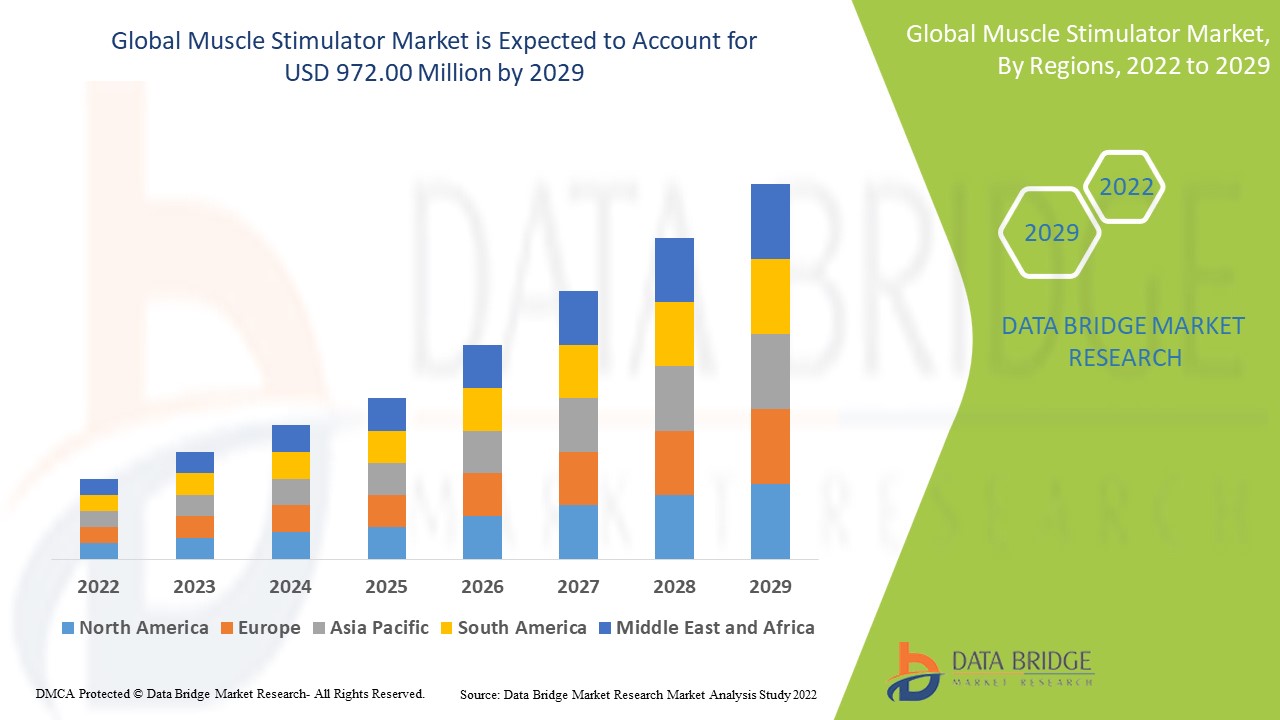Global Muscle Stimulator Market
Market Size in USD Million
CAGR :
% 
 USD
804.70 Million
USD
1,088.64 Million
2024
2032
USD
804.70 Million
USD
1,088.64 Million
2024
2032
| 2025 –2032 | |
| USD 804.70 Million | |
| USD 1,088.64 Million | |
|
|
|
|
Global Muscle Stimulator Market Segmentation, By Product Type (Neuromuscular Electrical Stimulation, Functional Electrical Stimulation, Transcutaneous Electrical Nerve Stimulation, Interferential, Burst Mode Alternating Current, Micro Current Electrical Neuromuscular Stimulator, and Others), Modality (Handheld, Portable, and Table Top), Application (Pain Management, Neurological Disorder, Musculoskeletal Disorder and Others), End User (Hospitals, Ambulatory Surgical Centers, Physiotherapy Clinics, Sports Clinics, and Home Care) – Industry Trends and Forecast to 2032
Muscle Stimulator Market Analysis
According to the National Center for Biotechnology Information (NCBI) reports that, in 2016 about 41.0% of Great Britain's population suffered from musculoskeletal problems. However, the American Academy of Orthopedic Surgeons estimates that in 2016, the illness afflicted about 126.6 million Americans.
Global Muscle Stimulator Market Size
Global muscle stimulator market size was valued at USD 804.70 million in 2024 and is projected to reach USD 1088.64 million by 2032, with a CAGR of 3.85% during the forecast period of 2025 to 2032.
Report Scope and Market Segmentation
|
Attributes |
Muscle Stimulator Key Market Insights |
|
Segmentation |
|
|
Countries Covered |
U.S., Canada and Mexico in North America, Germany, France, U.K., Netherlands, Switzerland, Belgium, Russia, Italy, Spain, Turkey, Rest of Europe in Europe, China, Japan, India, South Korea, Singapore, Malaysia, Australia, Thailand, Indonesia, Philippines, Rest of Asia-Pacific (APAC) in the Asia-Pacific (APAC), Saudi Arabia, U.A.E, South Africa, Egypt, Israel, Rest of Middle East and Africa (MEA) as a part of Middle East and Africa (MEA), Brazil, Argentina and Rest of South America as part of South America |
|
Key Market Players |
Boston Scientific Corporation (U.S.), BTL (Canada), Cyberonics, Inc. (U.S.), DJO LLC (U.S.), Medtronic (Ireland), Nevro Corp (U.S.), NeuroMetrix, Inc (U.S.), Abbott (U.S.), Uroplasty Inc (U.S.), Cogentix Medical (U.S.), Aleva Neurotherapeutics (Switzerland), NeuroPace Inc (U.S.), AxioBionics (U.S.), Beurer GmbH (Germany), Omron Healthcare, Inc (Japan), RS Medical (Japan) |
|
Market Opportunities |
|
Muscle Stimulator Market Definition
The muscle stimulators use electric current to elicit muscle or nerve contraction. The electrical signal mimics the intensity and frequency of the nervous system. Athletes can utilise muscle stimulators as a post-workout rehabilitation technique. These devices have electrode pads attached to the skin.
Muscle Stimulator Market Dynamics
Drivers
- Rising frequency of musculoskeletal ailments
The market is primarily being driven by the increasing use of muscle stimulators among physiotherapists, technological developments in medical devices, and the focus on pain management treatments in sports medicine. Additionally, it is anticipated that the increased frequency of musculoskeletal ailments among people will further propel market expansion.
- Need for muscle stimulation therapy among athletes
Muscle stimulators are becoming increasingly popular among physiotherapists as a treatment option for patients in clinical and home care settings since they are quicker and more efficient than manual procedures. The need for muscle stimulation therapy among athletes with hip flexor, hamstring, and anterior cruciate ligament (ACL) tears is also predicted to contribute to the expansion of this market.
- Rise in demand of patient visits
The primary drivers projected to propel market expansion include increased patient visits for stimulation therapies and the availability of these therapies at physiotherapy clinics at reasonable prices. Additionally, it is projected that the segment expansion would be fueled by the medical reimbursement offered to patients who seek these therapies over the projection period.
Opportunities
- Increase in the demand of stimulators
The market's growth is fuelled by growing demand for wireless and portable muscle stimulator and their compatibility with smartphones is creating growth opportunities for the market players. According to a factsheet released by the National Spinal Cord Injury Statistical Center in 2019, there are currently 291,000 persons living with SCI in the U.S., and there are around 17,730 cases reported year. Over the forecast period, it is anticipated that demand for NMES will rise as SCI prevalence rises.
Restraints/Challenges
- High cost
On the other hand, the high cost of muscle stimulator is encouraging customers to opt for cheaper alternative therapies such as acupuncture, yoga. which will obstruct the market's growth rate.
This muscle stimulator market report provides details of new recent developments, trade regulations, import-export analysis, production analysis, value chain optimization, market share, impact of domestic and localized market players, analyses opportunities in terms of emerging revenue pockets, changes in market regulations, strategic market growth analysis, market size, category market growths, application niches and dominance, product approvals, product launches, geographic expansions, technological innovations in the market. To gain more info on the muscle stimulator market contact Data Bridge Market Research for an Analyst Brief, our team will help you take an informed market decision to achieve market growth.
Muscle Stimulator Market Scope
The muscle stimulator market is segmented on the basis of product type, modality, application, and end user. The growth amongst these segments will help you analyze meagre growth segments in the industries and provide the users with a valuable market overview and market insights to help them make strategic decisions for identifying core market applications.
Product Type
- Neuromuscular Electrical Stimulation
- Functional Electrical Stimulation
- Transcutaneous Electrical Nerve Stimulation
- Interferential
- Burst Mode Alternating Current
- Micro Current Electrical Neuromuscular Stimulator
- Others
Modality
- Handheld
- Portable
- Table Top
Application
- Pain Management
- Neurological Disorder
- Musculoskeletal Disorder
- Others
End-use
- Hospitals
- Ambulatory Surgical Centers
- Physiotherapy Clinics
- Sports Clinics
- Home Care
Muscle Stimulator Market Regional Analysis
The muscle stimulator market is analyzed and market size insights and trends are provided by country, product type, modality, application, and end user as referenced above.
The countries covered in the muscle stimulator market report are U.S., Canada and Mexico in North America, Germany, France, U.K., Netherlands, Switzerland, Belgium, Russia, Italy, Spain, Turkey, Rest of Europe in Europe, China, Japan, India, South Korea, Singapore, Malaysia, Australia, Thailand, Indonesia, Philippines, Rest of Asia-Pacific (APAC) in the Asia-Pacific (APAC), Saudi Arabia, U.A.E, South Africa, Egypt, Israel, Rest of Middle East and Africa (MEA) as a part of Middle East and Africa (MEA), Brazil, Argentina and Rest of South America as part of South America.
North America dominates the muscle stimulator market due to the large investments by governments for innovation and development of medical devices.
Asia-Pacific is expected to grow at the highest growth rate in the forecast period of 2025 to 2032 due to the increasing awareness related to health and fitness and growing usage of smart devices for maintaining health are the key growth stimulants of the region.
The country section of the report also provides individual market impacting factors and changes in regulation in the market domestically that impacts the current and future trends of the market. Data points like down-stream and upstream value chain analysis, technical trends and porter's five forces analysis, case studies are some of the pointers used to forecast the market scenario for individual countries. Also, the presence and availability of global brands and their challenges faced due to large or scarce competition from local and domestic brands, impact of domestic tariffs and trade routes are considered while providing forecast analysis of the country data.
Muscle Stimulator Market Share
The muscle stimulator market competitive landscape provides details by competitor. Details included are company overview, company financials, revenue generated, market potential, investment in research and development, new market initiatives, global presence, production sites and facilities, production capacities, company strengths and weaknesses, product launch, product width and breadth, application dominance. The above data points provided are only related to the companies' focus related to muscle stimulator market.
Muscle Stimulator Market Leaders Operating in the Market Are:
- Boston Scientific Corporation (U.S.)
- BTL (Canada)
- Cyberonics, Inc. (U.S.)
- DJO LLC (U.S.)
- Medtronic (Ireland)
- Nevro Corp (U.S.)
- NeuroMetrix, Inc (U.S.)
- Abbott (U.S.)
- Uroplasty Inc (U.S.)
- Cogentix Medical (U.S.)
- Aleva Neurotherapeutics (Switzerland)
- NeuroPace Inc (U.S.)
- AxioBionics (U.S.)
- Beurer GmbH (Germany)
- Omron Healthcare, Inc (Japan)
- RS Medical (Japan)
Latest Developments in Muscle Stimulator Market
- In November 2020, Accufit, a new gadget for focused muscle stimulation with IntelliSTIM, was introduced by Lutronic
- In May 2020, the FDA granted emergency approval to Liberate Medical for its Vent Free Respiratory Muscle Stimulator, which promises to shorten the time patients are kept on a ventilator
SKU-
Get online access to the report on the World's First Market Intelligence Cloud
- Interactive Data Analysis Dashboard
- Company Analysis Dashboard for high growth potential opportunities
- Research Analyst Access for customization & queries
- Competitor Analysis with Interactive dashboard
- Latest News, Updates & Trend analysis
- Harness the Power of Benchmark Analysis for Comprehensive Competitor Tracking
Research Methodology
Data collection and base year analysis are done using data collection modules with large sample sizes. The stage includes obtaining market information or related data through various sources and strategies. It includes examining and planning all the data acquired from the past in advance. It likewise envelops the examination of information inconsistencies seen across different information sources. The market data is analysed and estimated using market statistical and coherent models. Also, market share analysis and key trend analysis are the major success factors in the market report. To know more, please request an analyst call or drop down your inquiry.
The key research methodology used by DBMR research team is data triangulation which involves data mining, analysis of the impact of data variables on the market and primary (industry expert) validation. Data models include Vendor Positioning Grid, Market Time Line Analysis, Market Overview and Guide, Company Positioning Grid, Patent Analysis, Pricing Analysis, Company Market Share Analysis, Standards of Measurement, Global versus Regional and Vendor Share Analysis. To know more about the research methodology, drop in an inquiry to speak to our industry experts.
Customization Available
Data Bridge Market Research is a leader in advanced formative research. We take pride in servicing our existing and new customers with data and analysis that match and suits their goal. The report can be customized to include price trend analysis of target brands understanding the market for additional countries (ask for the list of countries), clinical trial results data, literature review, refurbished market and product base analysis. Market analysis of target competitors can be analyzed from technology-based analysis to market portfolio strategies. We can add as many competitors that you require data about in the format and data style you are looking for. Our team of analysts can also provide you data in crude raw excel files pivot tables (Fact book) or can assist you in creating presentations from the data sets available in the report.














